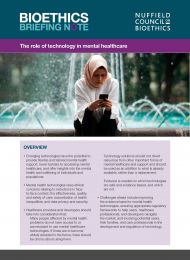The role of technology in mental healthcare
Policy Briefing
Published 28/04/2022

Our briefing note explores the ethical and social issues arising from the use of technology in mental healthcare.
Emerging technologies in mental healthcare
This section provides examples of emerging technologies that could come into widespread use in the future.
Smartphone apps and chatbots
Smartphone apps can offer flexible support, tailored to individuals' lifestyles and needs. Some apps are designed to improve wellbeing through activities such as meditation, self-help exercises, and mood tracking practices. Others use artificial intelligence (AI) to operate a chatbot and simulate conversations with users in order to provide assessments and suggestions to improve wellbeing.
Some apps aim to provide clinical support for people with mental health conditions. While particular attention has been given to mild depression and anxiety, apps for the treatment of severe conditions have also been developed. These are usually based on principles derived from existing therapeutic methods, such as cognitive behavioural therapy (CBT) and relaxation training. For example, some CBT-based apps teach people to manage depression by encouraging them to track symptom severity over time and keep a thought diary.
Predictive analytics
Digital phenotyping involves the collection of data outside of clinical settings to get insights into the behaviour and mental health of individuals and populations. Smartphones, wearables, and other devices with sensors are sources of a large amount of physiological and behavioural data. By monitoring changes in location, phone interactions and physiological measurements, researchers have been able to monitor treatment adherence and response in psychiatric patients, with the aim of helping to prevent relapses. The analysis of content posted on social media can also provide insights into the mental health of users. Facebook has developed an algorithm to identify posts from people who might be at risk of committing suicide or self-harm.
With advances in AI and computer science, it may be possible to use digital data to make predictions about people's mental health. In the future, machine learning (ML)* and natural language processing (NLP)** techniques could be used to predict people's likelihood of developing a mental health condition or possible clinical outcomes treatments. Researchers at the Alan Turing Institute are investigating whether NLP analysis of transcribed speech could help predict who is likely to develop psychosis in a population of at-risk individuals. If integrated with other information, the collection of speech data via personal devices could help clinicians track the progression of disease over time.
While methodological and technical limitations need to be addressed to draw definitive conclusions, including the need for larger sample size, there are hopes that digital phenotyping and computer science techniques will be able to help inform clinical decision-making in the future.
* Machine learning (ML) is a branch of AI and computer science focused on developing computer systems capable to learn and adapt without following specific instructions. It can be used to analyse and draw inferences from patterns in data.
** Natural language processing (NLP) is a branch of AI and computer science focused on the application
of computational techniques to the analysis and synthesis of natural
language and speech. It can be used to build machines that understand
and respond to text or voice data.
Immersive technologies
Over the past twenty years, researchers have investigated the use of virtual reality (VR) for the treatment of conditions such as phobias and post-traumatic stress disorder (PTSD). Recently, experimental studies have focused on the development of fully automated forms of support that can be delivered without the involvement of human therapists. A new automated VR therapy that targets social anxiety in patients with psychosis is currently being tested in several NHS Trusts as part of the gameChange clinical trial.
As it becomes more affordable, immersive technology is also starting to play a role in promoting mental wellbeing. Meditative games can help players develop a range of skills to manage stress and anxiety. In the meditative game Deep, users are led into an underwater world that can be controlled through diaphragmatic breathing with the help of a breath belt. This enables players to learn long-term meditative breathing and emotion regulation skills to help manage stress and anxiety, as well as improve mood and relaxation.
Consumer neurotechnology
Brain recording and stimulation devices were previously accessible only to clinicians and researchers. Now, these tools can be purchased directly by consumers and used to enhance wellbeing, reduce stress and anxiety, and improve mood. For example, by wearing a portable electroencephalography (EEG) device during meditation, electrical activity in the brain can be recorded and transferred to a smartphone application where it is immediately translated into a sensory signal. This real-time sensory feedback guides users during meditation.
Other neurotechnology devices are marketed for the treatment of psychiatric and psychological conditions. For example, a wearable transcranial direct current stimulation (tDCS) device can be used in combination with psychological therapy delivered though an app to improve symptoms of depression. The ethical issues raised by novel neurotechnologies have been explored in a previous Nuffield Council report.
Regulation of mental health technologies
Some mental health technologies, such as wearables and apps, are considered to be medical devices and are regulated by the Medicines and Healthcare products Regulatory Agency (MHRA). To qualify as a medical device, software, instruments and other tools must have a 'medical purpose'. The same tool might not be considered a medical device in a different context.
The distinction between health apps with medical and non-medical purposes can be nuanced, particularly in the case of mental healthcare and wellbeing apps. To help determine whether an app is a medical device, the MHRA has issued guidance on the regulation of software applications. The MHRA is currently in the process of reviewing its regulatory regime and intends to develop more provisions that can be specifically applied to software and AI.
In 2021, NHSX introduced the Digital Technology Assessment Criteria for Health and Social Care (DTAC) with the aim of providing national baseline criteria for digital health technologies entering into the NHS and social care.[iv] DTAC are designed for use by NHS organisations piloting, using or procuring digital health technologies.
The National Institute for Health and Care Excellence (NICE) provides an evidence standards framework for digital health technologies. NICE is currently updating the framework to include data-driven technologies that incorporate AI, with a consultation starting in April 2022.
The Regulatory Horizons Council is currently undertaking research with the aim of advising the UK Government on regulatory reform required to facilitate the rapid and safe development of neurotechnologies that interact with the nervous system, with a report due to be published by the end of summer 2022.[vi]
Many mental healthcare technologies do not fall under the category of a medical device nor are in scope to be assessed for use in the NHS. The regulatory landscape for these technologies has been called “fragmented and not fully developed” and there are calls for more work to help developers navigate the market.

Share